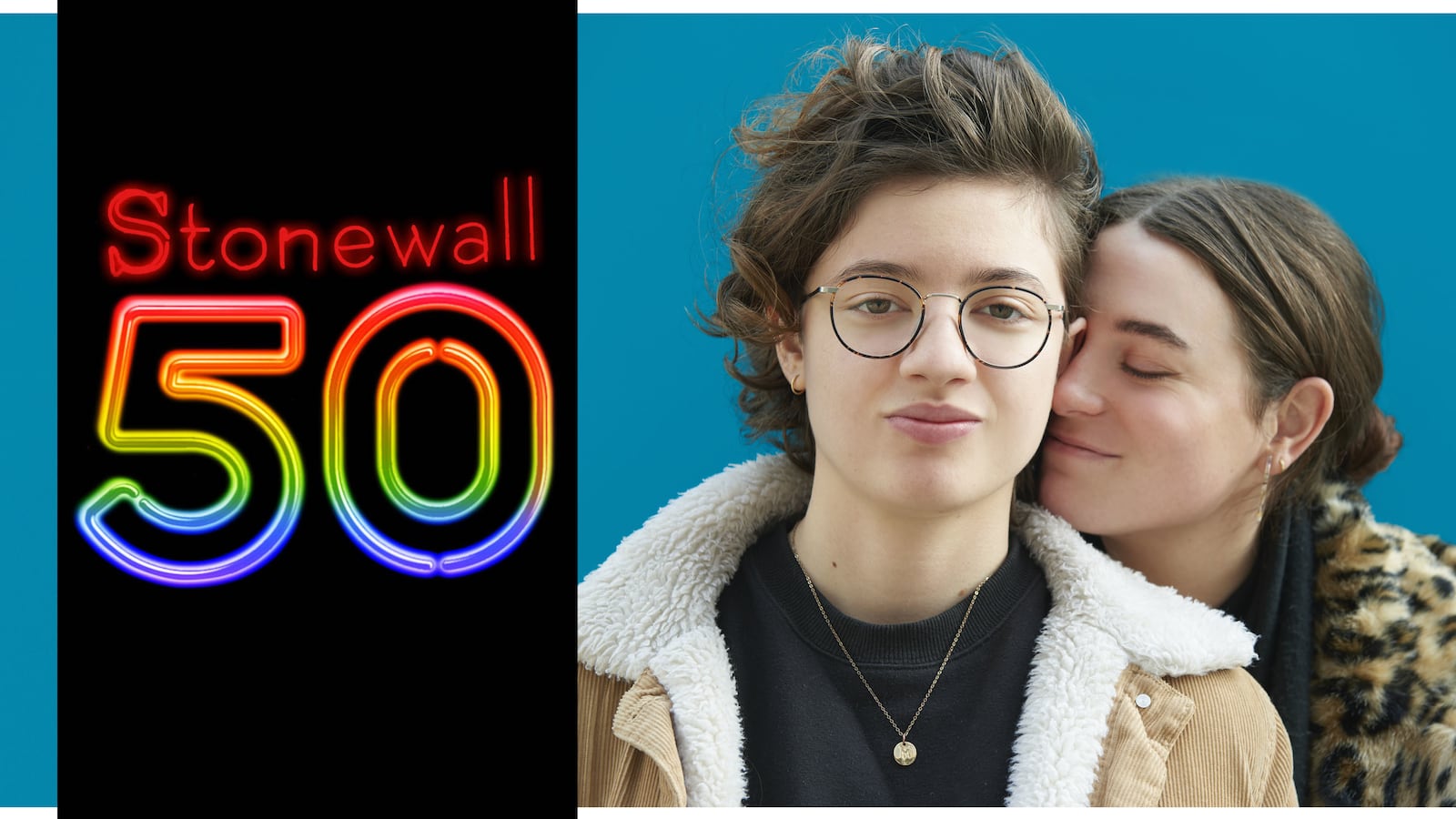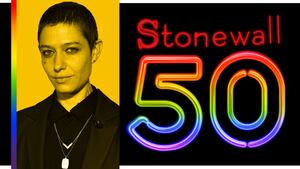My search started on a Sunday night in 2006. We sat around our cedar kitchen table, my parents rehashing that night’s 60 Minutes report. CBS featured a study claiming having older brothers increases the likelihood of a man being gay. (There wasn’t a correlation between lesbians and older sisters, and no comment on trans or non-binary folks.)
I, a closeted 9-year-old, didn’t speak. My older two brothers sat across from me, and I glared at them. But more than anyone else I was furious at Lesley Stahl. She wanted to out me.
Though I wouldn’t officially tell my family that I was gay for another eight years, my near-outing put me on a fast track to understanding this overwhelming sense of isolation. Lesley Stahl unlocked the closet door, and I feared Morley Safer or Andy Rooney might prop it wide open any given Sunday.
Starting that night, I spent almost every hour before bed on my phone googling phrases like “how many brothers make you gay?” and “gay life Lake County.” I did this for years. Along the way, with the help of Ask.com, chat forums and local news websites, I learned my queer history, including the seminal Stonewall Riots of 1969.
This is the beginning of my “Stonewall story,” how I came to understand the nights of civil unrest that if not kicked off the modern LGBT movement, certainly became its symbolic touchstone.
Most queer people have their own tales of driving miles to find that one bookstore, video store or gay bar where life started to make sense, and where Stonewall was first mentioned to them.
As a 9-year-old in 2006, mine took place online. There’s a belief Gen Z queers (roughly those born between 1996 to 2012) are entirely informed about our queer roots because we had iPhones in our hands before high school. We have instant access to endless digital histories via Wikipedia entries, YouTube clips and now even the AIDS Memorial Instagram. But all this information hasn’t made the coming-to-terms and coming-out process any less torrid.
A recent study by the Trevor Project found that two out of three LGBTQ youth had someone try to convince them to change their sexual orientation or gender. Additionally, 40 percent of LGBTQ youth have considered suicide in the last year. The stats are even worse for trans and non-binary kids, where more than half have seriously considered suicide. The assumption younger LGBTQ people are OK is just that—an assumption.
“The first time I heard about Stonewall I was probably 14,” said Eva Reign, an early-twenties trans woman who lives in New York. Growing up in the rural suburbs of St. Louis, Reign’s community didn’t offer outlets to explore her burgeoning identities. So she went online to connect with other Gen Z queers. “I was very much being demonized for who I am, and Tumblr was the one space that made me feel it’s actually totally normal,” she said.
Tumblr more than any other social media was a 24/7 safe space for queer youth. A 2017 Australian survey noted LGBTIQ+ youth used Tumblr disproportionately higher than other demographics.
Sadly, that’s fading as Tumblr’s recent Adult Content ban erased accounts with sexually explicit content, which often includes queer accounts. It’s made worse considering the Trevor Project also found a staggering 98 percent of LGBTQ youth said a queer social media safe space would be valuable.
The lack of offline queer resources left Reign feeling disconnected to Stonewall until she moved to New York after college to pursue an acting career. “I’ve been thinking about that a lot as we reach the 50th anniversary. People typically are only really about the big cities, like the really, really big cities,” Reign said. “I was interested in the immediate local queer history around me, and a lot of those don’t have documentation.”
Several hours north in the suburbs of Minneapolis, Phillipe Thao stumbled up a pristine piece of queer documentation.
While reading the local Hmong Today newspaper, Thao saw an ad for Shades of Yellow, a nonprofit serving queer Hmong folk in the Twin Cities. Even more surprising, he recognized his female cousin in the feature photo, kissing a woman.
“I remember my mom showing it to me, and at the time she was kind of talking down on it,” Thao, a 23-year-old queer male who now lives in Chicago, said. Shades of Yellow intrigued him until a Google search revealed he was too young to join the only group he knew for people like him.
A few years later and after he’d come out, Thao was ready to join his fellow queer Hmongs and googled Shades of Yellow again. The 14-year-old organization had folded over a lack of funding.
“Even today, I feel a lot of sadness. Minnesota has the largest Hmong population in the country, and there’s no organization and resources for other queer Hmong youth like me who could have needed it,” Thao said. “I feel an obligation to do something about that one day.”
Since local queer histories are often lost or largely unacknowledged, queer youth latch on to any piecemeal of identity they can find. Be it Buffy the Vampire Slayer, Frank Ocean or even cartoon Disney villains. This isn’t a uniquely Gen Z experience. But Glee is.
The Glee phenomenon can’t be understated in helping 2010s youth feel comfortable coming out. I still get butterflies watching Darren Criss perform “Teenage Dream” to Chris Colfer, the first time I remember seeing gay kids in love on TV. “When I was 14, I came out to everyone. Even though they all kind of assumed, I don’t think I would have had the courage to do that without watching Glee,” Eva Reign said.
But Glee—and last year’s films Love, Simon and Alex Strangelove—predominately highlight the cisgender, white sliver of the queer teen community. This isn’t new. In GLAAD’s yearly report of LGBTQ representation in film, gay men are reportedly the most represented of the marginalized group.
For the first time in their reporting history, lesbians and bisexual men both represented 55 percent of the meager 18 percent of all films to feature an LGBTQ character. Not a single major studio film in 2018 featured a trans or non-binary character.
All too often, historical accuracy is lost as a result. Depending solely on entertainment to offer rich, nuanced cultural history will inevitably leave holes in the story.
In last week’s Season 11 finale of RuPaul’s Drag Race, RuPaul offered a brief history of the Stonewall Riots but didn’t mention by name Marsha P. Johnson, a lionized activist who was present at the riots.
Just a few months prior on All Stars Season 4, the show controversially gave the honor of inciting Stonewall to Judy Garland’s death (this isn’t true). Neither went unnoticed on Twitter.
“A lot of whitewashing exists, and because of that people's stories get revised, ignored or shafted—like that Stonewall film,” Julien, a 21-year-old queer person from Canada, said.
Almost every queer Gen Z person I spoke with mentioned Roland Emmerich’s 2015 film Stonewall as an example of erroneous and whitewashed queer history—and it was panned by many critics including the Daily Beast’s Tim Teeman. Jeremy Irvine stars a white cis man throwing the first brick and inciting the riots. Again, Johnson and her fellow trans activist Sylvia Riveria’s monumental influence is downplayed.
As alternatives, most of my interviewees suggested the documentary Paris Is Burning and FX series Pose as the shows opening their world to a more diverse queer history. Both depict New York’s 1980s queer ball culture. “They’re black, and they’re like me,” added Reign, who first saw Paris Is Burning as an illegally uploaded YouTube video. “Most films only really show white people. That was a really cool moment in life as well.”
One sentiment that does transcend queer generations is the importance of oral histories as a way to foster intergenerational queer connection.
“We kind of owe it to listen to them. To analyze what these people were fighting for and make sure we’re not losing focus,” said Marcos, a 17-year-old trans man from Colorado who hides their gender identity at school after repeatedly being attacked by transphobic classmates. (LGBTQ Youth are two times as likely to be physically assaulted.)
In turn for respectively listening to their stories, he would like older generations to “trust in the future of the community and how we’re going to approach activism. It should be reciprocal.”
Increasingly, many teens and children don’t have to leave home to find hear first-hand accounts of the queer life in the 20th century. GLAAD estimates today more than 10 million people have one or more LGBT parents.
Sadie Ronga-Rubin, a 22-year-old trans, non-binary person from New York, feels “extremely privileged” to have lesbian parents who were out as early as the 1960s. “Seeing pictures of my parents at GLBT marches in the ‘80s is really eye-opening,” they said. Ronga-Rubin learned early from their parents the important role lesbian activists played in caring for gay and bisexual men dying of AIDS.
It’s with their parents’ friends that Ronga-Rubin found the greatest intergenerational connections.
“I see myself in a lot of older trans masc people who maybe identify as butch or otherwise,” they said. Ronga-Rubin’s parents initially wondered why their child couldn’t just identify as butch instead of trans. “A lot of butches in history have been conflated with a trans identity, and, in some cases, the language just wasn’t there it.” Things are different today, and their parents have come around. “You can also be butch and trans. The discussion is a lot wider today surrounding language.”
Others are still waiting to feel included in modern-day queer communities. Raised by bisexual parents in the UK, Kelvin Sparks identifies as a trans and bisexual man. At 8 years old, he first learned about the devastating impact AIDS had on trans and bisexual people in the 1980s. Sparks also identifies as intersex, though doesn't have the same understanding of intersex history.
“When I think about myself as a trans person, I find comfort in thinking of myself as part of a community with a long legacy, because there was so much activism that predates my existence,” he said. “Whereas with intersex activism, it's so new that I don't feel that drive or need to find that comfort.”
As more and more children of queer parents grow up, they’re bonding together. Emily Harnett, a 20-year-old bisexual woman from the suburbs of Philadelphia, grew up the daughter of two queer women.
On the soccer field or in the classroom as a kid, Harnett’s peers often asked her if one of the women standing on the sidelines cheering her on was her aunt or grandma. “It’s not even about closeting yourself but closeting your family,” Harnett said, who as early as third grade realized she didn’t know anyone else with queer parents.
She turned to organizations like Colage, a national organization connecting children of LGBTQ parents. Her experience of coming out as bisexual is different than her parents, her friends or other any other queer person’s. It’s why, no matter the age, coming out and finding pride is still a deeply individual journey. One that might start online but often ends on a parade route.
“There’s a certain feeling of stepping on the parade route with your parents that you’re so proud of them to be able to come through all of this history and everything that has happened in their lives,” Harnett said, who attends Philly Pride with her moms every year. “To be standing there with them is the most beautiful moment.”
That night in 2006, Lesley Stahl might have spurred me to understand what it means to like men, but it is the vibrant queer histories I have uncovered, and continue to uncover, that made me proud to be gay.


